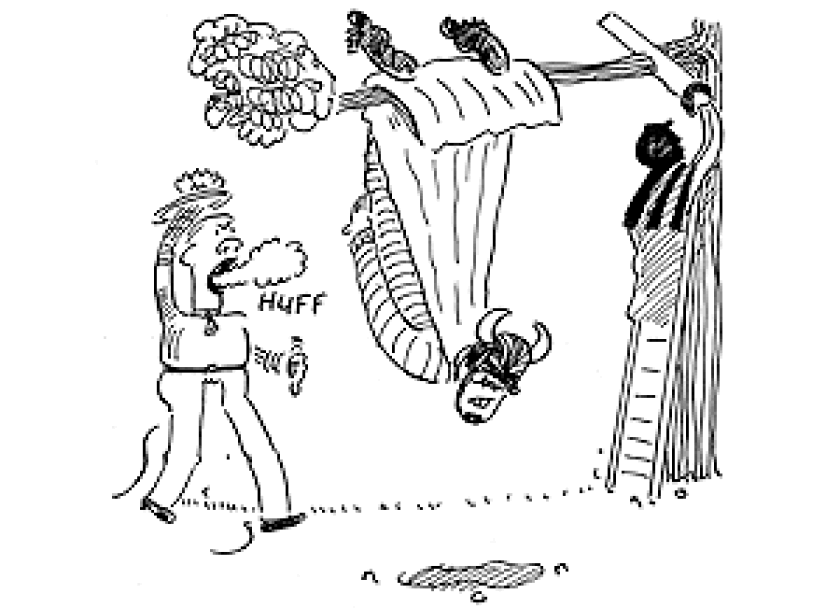Dear Cecil: I’m sure you saw the story about the man who decided to cross 1,000 miles of ocean from Florida to Bermuda in an inflatable bubble. Several days later, he had to be rescued via helicopter. That probably wasn’t cheap, and someone has to pay for it, and I suspect it ends up being you and me. My guess is knowing someone will try to rescue them is why daredevils take these risks. But why should the taxpayers have to cover the cost? Jim Huff
Cecil replies:
You sound like a sensible chap who never puts himself in idiotic situations, Jim. I’m sure you floss twice a day and never mix beer with liquor. Taxpayers around the country applaud your efforts. Luckily, not everyone thinks like you — otherwise we never would have put a man on the moon. (And yes, we did; that conspiracy theory was debunked here years ago.)
Daredevils have been at it since Icarus flew too close to the sun, so I don’t buy the idea that a free rescue is their primary motivation. That said, it’s worth investigating (a) whether the availability of government bailouts creates what economists call a moral hazard — a situation where people take greater risks because they know someone else will bear the cost — and (b) whether taxpayers are shouldering too much of the burden. And yes, we’re talking here about physical stunts, not banking practices, but one can see how this theme might easily be expanded.
For simplicity, we’ll focus on search-and-rescue (SAR) statistics on Mt. McKinley over the last century, which initially seem to support the idea that such measures do more harm than good. For the decade after McKinley was first summitted in 1903, the fatality rate was an impressive zero percent — only serious climbers made attempts. Fatalities remained low until helicopter SAR efforts started becoming commonplace, around 1976. In the following decade the number of people attempting the summit increased by 1,500 percent, and fatalities more than doubled.
Theoretically, greater safety measures may in fact cause people to take more risks — a phenomenon known as the Peltzman effect, after the researcher who showed that wearing seat belts correlated with riskier driving. But the effect on mountaineering soon leveled off. Since the 1980s, the fatality rate per climber attempt at McKinley has fallen more than 90 percent.
So in fact the numbers suggest that overall climbers are indulging in far less foolish behavior than before the increase in SAR efforts. The question remains whether the rest of us should be made to pay for other people’s poorly developed prefrontal cortexes.
There’s plenty of anecdotal evidence that advances in rescue technology have caused people to make foolish decisions at taxpayers’ expense. The advent of personal satellite locator beacons like the one our hamsterlike hero, Reza Baluchi, used to call emergency services from his ball in the ocean — the California SAR chief has nicknamed the devices “yuppie 911” — has given rise to many such stories. One Grand Canyon camper summoned a rescue mission, costing $4,000-plus per hour, because she heard “odd noises emanating from the leader of the group as he slept.” By the time rescuers arrived, the caller was asleep herself, apparently no longer too concerned. Similarly, simply carrying a mobile phone may make thrill-seekers too quick to call for help.
The price of a serious rescue can be steep — the 1998 rescue of two McKinley climbers at 19,000 feet cost $222,000. From 1992 to 2007 the National Park Service performed 65,439 SARs, at an average cost of $895; the average mountain rescue, though, sported a $27,000 price tag.
Would some of these people have been deterred if no rescue were promised, or if they had to pay for their rescues themselves? Probably. Would either measure improve the situation? Definitely not.
In the grand scheme, rescuing people just isn’t that big a deal financially. All those rescues between 1992 and 2007 cost $3.7 million a year on average — a paltry 1.2 cents per American. It’s fair to say most of that was spent not on daredevils but on reasonable, risk-averse people like yourself. Only about 5 percent of SAR efforts deal with rock climbing and mountaineering — i.e., more obviously risky behavior — whereas day hiking, boating, and swimming account for 72 percent. A review of 18 years of SARs on McKinley classified just 9 of 261 rescues as due to inexperience, and only 4 were false alarms.
There’s also the moral issue: charging for rescues could cause people who are genuinely in trouble to hesitate when calling for help, resulting in more deaths and serious injuries.
Finally, the practical question: what public official is going to advocate denying rescue efforts to people who can’t pay the bills? Some states do charge small fees — Oregon requires people to pay up to $500 per rescue, for instance — but this is only intermittently enforced.
We know you wouldn’t be caught dead in an inflatable sphere in the middle of the ocean, Jim. Surely, though, you won’t begrudge a 1.2-cent contribution towards helping those with less brains than you but more balls.
Cecil Adams
Send questions to Cecil via cecil@straightdope.com.
